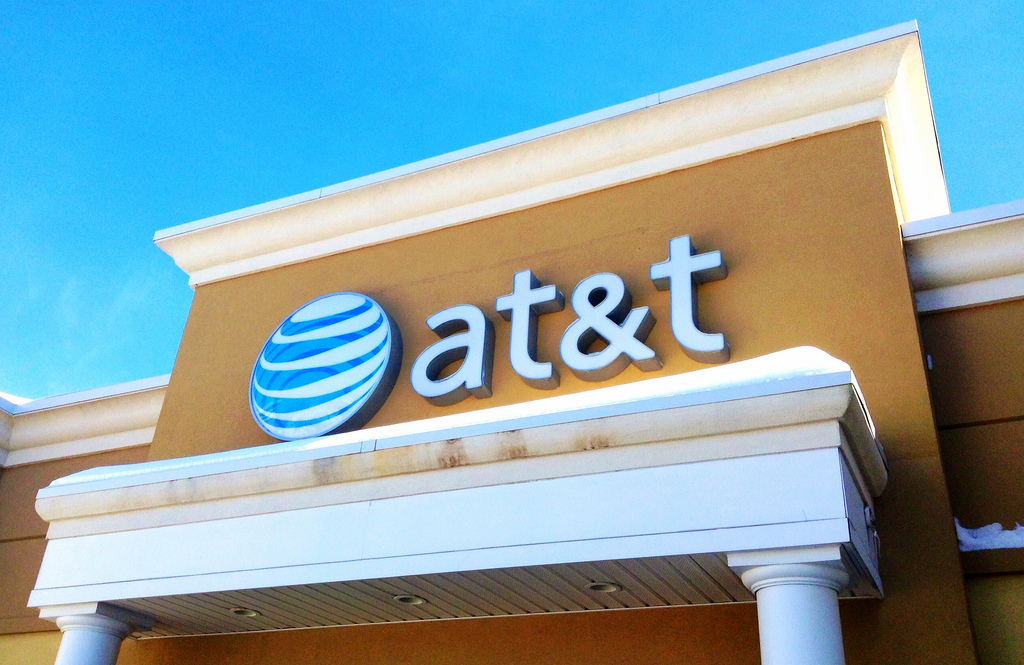Photo: Flickr.com/Mike Mozart
About AT&T
AT&T is one of the world’s largest telecommunications companies, providing landline and wireless phone services across the United States and the world, along with Internet Protocol-based television services. AT&T also operates over 32,000 Wifi hot spots across the United States.
AT&T was formed out of telephonic technology developed by Alexander Graham Bell in 1876 and 1877. In 1877, the Bell Telephone Company was formed and a year later licensed the technologies the company had developed to create the nation’s first telephone exchange in New Haven, CT. In March 1885, the American Telephone and Telegraph Company was formed as a wholly owned subsidiary of Bell Telephone to build and operate the nation’s first long distance telephone network. Starting in New York, the network reached Chicago in 1892 and made it across the country to San Francisco in 1915. Along the way, AT&T purchased the assets of Bell Telephone to become the parent company of the Bell System.
As the national telephone network developed through World War I and World War II, AT&T evolved to owning seven regional Bell Companies that were responsible for operating local exchanges, while AT&T was responsible for the national long distance network and research & development. The entire company operated as a regulated monopoly. In an agreement with the Justice Department in 1982, AT&T agreed to divest itself of the companies that provided local exchange service – the “Baby Bells”. The divestiture became effective on January 1, 1984 and the regional Bell operating companies were created.
As AT&T adjusted to business separate from the Baby Bells, the company purchased computer maker NCR in 1991 and McCaw Cellular (now AT&T Wireless) in 1994. The following year and into 1996, AT&T restructured and split into three separate companies: NCR (computers), Lucent (systems and equipment) and AT&T (communications services). Over the next four years, AT&T continued to adapt to the constantly changing business environment and in October 2000 announced its split into three separate companies: AT&T Wireless, AT&T Broadband (which was bought by Comcast) and AT&T.
Further information on AT&T’s history is available at the AT&T Corporate website.
The company is a member of the Dow Jones Industrial Average and the S&P 500 index, and trades under the ticker symbol T.
AT&T’s Dividend and Stock Split History
AT&T began increasing dividends in 1985, making 2009 the year the company became a Dividend Aristocrat after 25 years of dividend increases. Since 2004, AT&T has announced annual dividend increases in October, with the stock going ex-dividend in the following January.
AT&T has compounded its payout at an average rate of 2.1% over the last 5 years and 2.3% over the last 10 years.
AT&T has split its stock four times. In April 1959 AT&T stock split 3 for 1, and five years later, in May 1964, again split 2 for 1. 35 years later, in April 1999, AT&T stock split 3 for 2. Unfortunately, and unique to AT&T among the Dividend Aristocrats, AT&T stock had a reverse 1 for 5 split in November 2002. Companies usually conduct a reverse split when their stock price falls too low, and allows the company stock to continue trading on major stock exchanges. In general, reverse stock splits are an indication that the company is struggling, which is reflected in the low stock price. In this case, investors had every five shares of AT&T replaced by a single share, worth 5 times the value of the prior shares so that there’s no net effect on the value of an investor’s portfolio. The reverse split in 2002 negated nearly the entire positive effect of prior AT&T splits, so that one share of AT&T purchased in 1959 would have become 9 shares in April 1999 and then 1.8 shares at the end of 2002. In addition, AT&T had spun off the “Baby Bells” in the meantime, which would have enhanced an investor’s return.
AT&T’s Direct Purchase and Dividend Reinvestment Plans
AT&T has both direct purchase and dividend reinvestment plans. ComputerShare is responsible for administering both plans. The minimum initial investment, whether by check or direct debit, is $500. The minimum for additional investments is $50.
Both plans have purchase and sales fees. Initial investments have a $10 setup fee plus a 5 cent per share transaction fee. Follow on investments by check have a $2.50 service fee plus a 5 cent per share transaction fee. Follow on investments by direct debit incur a $1 service fee plus the 5 cents per share transaction fee. When reinvesting dividends, there is a 5% service fee on the reinvested amount, up to $2.00, plus 10 cents per share.
When selling shares, investors pay a service fee of $20 for market orders (where the order is processed as quickly as possible; the investor must do this through the website or by telephone) or $10 for batch orders (where the order is processed along with other sales, but there is a delay; this can be done by mail). All sales also incur a 10 cent per share transaction fee.
There are additional fees for holding the shares in an IRA. Complete information about the fees is available through the ComputerShare Investment Plans website for AT&T.
Helpful Links
AT&T’s Investor Relations Website
Current quote and financial summary for AT&T
Information on the direct purchase and dividend reinvestment plans for T

Pingback: Dividend Aristocrats Week in Review for June 28, 2014: AT&T, McCormick Announce Regular Quarterly Dividends